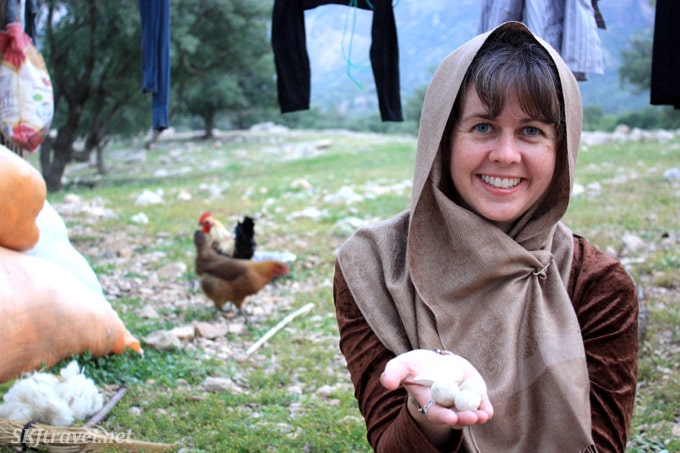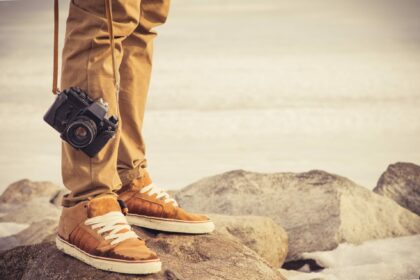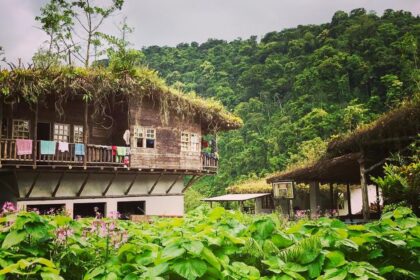
Think you can’t travel to Iran? Think again. Epicure & Culture caught up with intrepid traveler Shara Johnson, editor of SKJ Travel, who recently returned from a trip through the country. For those interested in going themselves — or just curious about what the experience is actually like and want an answer to the question, ” Is Iran Safe ?” — Shara provides stories, essential tips and safety information for traveling through Iran based on her own experience.
1. Iran isn’t a destination you hear many travelers talking about. What made you decide to go there and what type of traveler do you think would enjoy going to Iran?
I’ve actually always been interested in that region of the world because of my interest in ancient history. In more recent years, I also have taken more interest in architecture. Those two things were primarily what drew me there.
The political climate back in February 2014 when I booked our trip seemed the best in decades, so I decided it was time to go. Frankly, I can’t imagine excluding any type of traveler from enjoying this country. You can travel on a budget or in a more luxury fashion; you can travel independently (if you’re not American) or with a group; the architecture is spectacular; if you like shopping, the bazaars are a delight; the citizens are incredibly friendly – Iranian hospitality is renowned; you can visit ancient cultures like the nomads or modern cities like Shiraz and Isfahan. These activities are combined with that fact Iran is a large country with widely varying ecosystems from the ocean to the mountains, deserts to lush forests.
I think the only requirement is that you leave any fears behind — because they are unwarranted — and clear your mind of preconceptions, because they will only be disproved. If you can do this, you’re the type of traveler who would enjoy Iran. We actually saw tons of European travelers, so I think this applies more to Americans than to anyone else.

2. For those wanting to experience local culture in Iran, what do you recommend?
Well, naturally a tea house would be on the agenda, especially one with live traditional music — the locals will be clapping their hands and singing along. Iranians are champion tea drinkers and picnickers. So pack a thermos of tea and head out for a picnic! You should try a hooka — flavored tobacco to smoke — as well.
The real “culture” of Iran is the Persian culture. Some people don’t realize Iranians are not Arabs, they’re Persians who were conquered by the Arabs in the 700s. So perhaps visiting some traditional cultures is my best recommendation. For example, we spent a night with a nomadic family in the Zagros Mountains. We just hung out with them in their camp — and drank lots of tea, of course. They fixed us dinner and we ate with them. It wasn’t a real touristy thing — no special tents set up for visitors or any kind of practiced demonstrations or whatnot. Our guide called them up on his cell phone (yes, everyone on the planet has cell phone … except me) and asked if they were stationed at one of their camps. We got in a jeep and drove there, set up a regular two-man camping tent for ourselves on a flat grassy spot, and just shot the breeze around their campfire for most of the evening. Other old villages such as Abyaneh give you a glimpse at pre-Arab culture as well.
3. For someone wanting a traditional meal in Iran, what would you recommend they try?
The obvious answer is kabobs and tea. Lamb and chicken kabobs with gobs of saffron rice and naan-type bread are really the mainstays. Eggplant (aubergine) is a very common dish, usually in some kind of stew or broth. And if you really want to be Iranian, you will eat a raw onion with your meal. Not onion slices, but an actual whole onion – bite into it like an apple. And have a plate of raw basil or other herbs, this is very common. I made little basil sandwiches by just folding over a piece of naan and stuffing in the leaves.
4. For those wanting to partake in some adventure, what’s something in Iran they can do?
There are things like hiking, climbing and mountaineering as well as some ski resorts. I know that you can take horse-riding tours and travel for weeks through the country on horseback. Whitewater rafting is a pretty new adventure activity in Iran, so you could be one of the first people to do something like that. The most adventurous thing we did was camping with the nomads, as explained above in Question #2. Not exactly adrenaline-pumping, but definitely culturally adventurous and it did require sleeping on a very hard ground in a small tent.

5. What tip(s) would you give backpackers and extreme budget travelers heading to Iran?
I can’t speak to this very well since we had a relatively luxurious trip, as it’s the only kind of trip an American is allowed to have, staying in 3- and 4- star hotels, which were, incidentally, a very good value for the money. For anyone who is not American (see Question #10 for USA restrictions), I can tell you there is a huge Couchsurfing community thriving in Iran.
Generally, items you buy in the bazaar are cheaper than in a shopping mall, so if you want clothes or other practical items — and of course souvenirs — go to the bazaars.
6. For those wanting to assimilate into local culture, what’s one etiquette rule they should remember to avoid offending locals in Iran?
Women have to be the most careful. For example, if your head scarf falls off or you’re walking around bare-headed – this can really upset some people. And follow the other dress codes of long sleeves and a shirt length that covers your butt. Don’t offer your hand to a man to shake it — only if he extends his first. Most men working in tourist areas are perfectly comfortable interacting with women in a Western fashion. But other people on the street may not be.
For both sexes, don’t give a thumbs-up sign with your hand; it means the same as the middle finger does in America. Though, if a foreigner puts their thumb up, Iranians do seem to understand we are just ignorant of what it means.

7. Are there any local accommodations you would recommend in Iran that reflect the local culture or have a lot of character?
You can stay in old caravansaries — places where people, mostly merchants and traders, in antiquity stopped for food and accommodation. These will most likely be outside of cities kind of in the middle of nowhere along the ancient trade routes such as the Silk Road. But they’re quite an authentic experience of historical culture.
Other cool accommodations are old homes of the elite converted into hotels. Yazd has several of these. This is a growing trend throughout Iran — as tourism increases they are running out of hotel space — and especially in smaller cities, they’re taking advantage of these old homes to convert them into hotels because they typically have many rooms and courtyards.

8. What cities or regions in Iran would you recommend travelers to spend the most time in?
I can only speak of the central corridor of Iran, which is the main tourist circuit for anyone with limited time. We had only 15 days, so we stuck to that route. Of those cities, I would most recommend Yazd and Isfahan.
Yazd is a city that has really preserved Persian tradition and innovation – it contains probably the best illustrations of Persian ingenuity when it comes to learning how to live comfortably in the desert (ancient cooling technologies, etc), as well as artifacts of the Zoastrian religion, the original religion of the Persians. Today it is kept alive by only a small number of people — about 20,000 — and a flame that has been burning for 700 years! In Yazd, they even practice a form of traditional athletics used to train for sword fighting.
Isfahan is a beautiful city brimming with splendid architecture in its wealth of mosques and former palaces (Isfahan was once the capital of Iran). Its bazaar is also amazing and huge – so many side alleys and courtyards. There’s an Armenian quarter which has a lovely Christian church in it. One of my favorite activities was walking along the bridges at night, where locals sing underneath them. We stayed in Isfahan four days and nights. If you enjoy architecture and interior design, this is definitely a city for you.

9. For history buffs visiting Iran, what’s a recommended experience?
Oh boy, there’s a lot of good stuff. The piece de resistance, though, is certainly Persepolis — the ceremonial city of the ancient Persian empire, built in the 500s BC. Also check out the nearby associated necropolis. The Tomb of Cyrus the Great is also located near there. He was the founder of the Persian empire and probably the single most revered historical figure by all Iranians, who are immensely proud of their long cultural heritage.

10. What are some things travelers need to think about BEFORE leaving their home country for Iran?
Most importantly, Iran is a cash-only society. Owing to international sanctions, they can’t have associations with foreign banks and credit companies. So as a foreigner, you cannot access your personal funds from within Iran. You have to carry with you in cash enough money for all your foreseeable travel expenses. Fortunately, things like mugging, pickpocketing and robbery are rare, which helps ease a little of the anxiety of carrying around so much cash. Your ATM card will be utterly useless, your credit card will be useful only if you wish to buy a Persian carpet from a relatively large dealer, which will run you several hundred to several thousand dollars (they process payments through Dubai).
For Americans only, know that you need a minimum of two months and up to two-and-a-half months to obtain your visa. It takes 45-60 days to get an approval number, then you have to mail your passport in to the Pakistan Embassy. You must have your flight booked before applying for the visa. Also, Americans can’t travel alone — they must travel with a tour group or with a private guide. You will have to give the name of the tour agency or guide that you are using when you apply for your visa, and it’s best to simply let the agency handle the application on your behalf. Don’t try to skirt this restriction. Even if you somehow manage to lie your way into the country, it’s actually illegal for Iranians to host Americans in their private homes (which is why Couchsurfing is impossible) and you could get your host into trouble. My husband and I hired a private guide through an Iranian agency and it turned out to be an awesome experience. Our guide was stellar and really made the trip for us.

11. Were there any instances during your trip to Iran where you felt unsafe?
Yes! Every time I crossed a street in a city. The traffic is terrifying to a pedestrian. At first I thought I was just getting old and losing my nerve. I’ve crossed many crazy streets in other foreign countries. But then I read other guidebooks and websites that say traffic is the biggest danger to tourists.
Driving on the highways was scary sometimes, too; twice we were almost run off the road by big trucks who didn’t see our little car. Everyone drives in the dead-middle of a road with two lanes. White lines painted on pavement are utterly pointless in Iran.
However, other than around vehicles, no, I never once felt remotely unsafe in any way. So, is Iran safe ? You won’t meet people any more friendly than Iranians. They were even extra friendly if they found out we were American – they were so pleased that we weren’t afraid of them and were visiting their country.
12. For solo travelers heading to Iran what advice would you give? How can they stay safe?
I don’t really see any safety problems for solo travelers and traveling to Iran as a woman alone.
As I said, things like theft are rare, and the locals are ridiculously hospitable. In the major cities, tourists are everywhere, so it’s not like you would stick out in any way as being alone. You can’t really rent a car, so you either have to use public transportation or hire a guide to drive you. Public transportation is very cheap, even domestic airfare.

13. What are some misconceptions Westerners have about Iran?
Well, I think probably a whole book could be written on this topic. I don’t even know where to begin or end. One thing about having such a knowledgeable and fluent English-speaking guide for 15 days with whom we got along so well (just luck that we were so compatible with one another) is that he invited us to hang out with his friends and family, so we got pretty unparalleled insights (for foreigners) into the private lives of the average 20- and 30-year old citizen.
Our guide, and therefore his friends, trusted us enough to talk very frankly about their personal lives. The thing is, Iranians must lead double lives – the public life, which is visible to government authorities who can dish out really unpleasant punishment if you aren’t a good and devoted Muslim abiding the ayatollah’s creeds, and the private life, which unfortunately, I can’t really discuss here (nor on my own blog). It’s prudent that I don’t reveal what all we did and talked about out of concern for the safety of those we met.
Just consider one very public example of the conflicting behaviors and ideologies in Iran: the ayatollah is the supreme leader, he is the dictator of religious edicts which take precedence over all other forms of law; he has outlawed all social media in Iran. But not only do practically all the younger citizens have social media accounts anyway, through proxies, the democratically-elected president of the country has a Twitter account and Tweets to an international audience. The revolutionary guard is the ayatollah’s military arm, but everyone we spoke with said they consider the revolutionary guard an embarrassment and wish they would go away. They said it is full of uneducated zealots (most people used more derogatory terms than “uneducated”).
People we just met on the streets, who came up to us as Westerners and asked where we were from, were so pleased we were visiting from America, and asked us, “Why does America hate us?” Or they would say, “See, we’re not such terrible people!” They were genuinely hurt that Americans think so poorly of them. One of our guide’s friends asked me, “Why do Americans think we are all such mindless religious radicals?.” You can imagine the long discussion that ensued. Young Iranians clamor after Western goods and entertainment as much as anyone. They can’t get a lot of it because of the sanctions, but they are very creative in finding ways around both sanctions and laws. There is a healthy black market for a number of illegal material items. Many people have also learned how to procure and hide illegal satellite dishes on their homes.
I think many Americans picture Iranians at home building bombs, plotting attacks and chanting “Death to America” while they pour their tea. The average Iranian comes home from work, changes into more comfortable clothes (women often shedding head scarves and chadors), pops on the TV – likely tuned to an illegally accessed American sitcom — checks their illegal social media accounts, and maybe reads some Persian poetry. Or goes on a picnic with friends.
Also because so very little actual information about the country and its citizens is broadcast or written in the West, we’re all still stuck in 1979 when Iranians took Americans hostage. That was a unique time of upheaval, the beginning of the revolution. A revolution that most citizens had no idea would lead to the current state of affairs, they were simply eager to overthrow the king (shah), and the ayatollah and his minions moved in and clutched the country in an iron fist before the rational people could really blink and grasp what was happening. Post-revolution Iran is like Maoist China and Soviet Russia. If the ayatollah were to be overthrown now, the majority of the population would breathe a sigh of relief. But nobody can say that in public. I recommend reading the book, “The Cypress Tree,” by Kamin Mohammadi for an insight into how the revolution affected many of the normal citizens and stripped away their freedoms.

14. For those wanting to experience Iran with a local guide, is there a guide or tour company you would recommend or not recommend?
Yes! We adored our guide, and the tour agency we used was very good, as well. It was just pure dumb luck we ended up with Reza, our guide for all 15 days, as most guides contract independently with the tourist agencies in Iran, so you could end up with anyone. We used Gasht Tours to obtain our visa approval, and we followed one of their itineraries — they booked all of our hotels and provided the guide. It’s definitely cheaper to use an Iranian agency than an American/Canadian/European touring company. I would love to recommend our guide, whom you can contact at Hamzeh.Rezaee [at] gmail.com.
*All photos courtesy of Shara Johnson
Have you traveled to Iran? Are you planning a trip to Iran? Please share in the comments below.
About The Author
Shara Johnson plots her travels abroad from her home in the Rocky Mountains of Colorado, where she also hosts other travelers as an Airbnb host. Visit her Iran archive to read more about her experiences in this country. You can follow all her adventures abroad at SKJtravel.net. Friend her on Facebook or follow her on Twitter.
Also Check Out:
Going Local On Italy’s Amalfi Coast
Earth Lodge: A Soul-Finding Farmstay In Guatemala
Wellness Travel: Top Fourteen Yoga Fusion Retreats
Urban Escape: Glowing Flowers In Central Park NYC [Photo]
Jessica Festa
Latest posts by Jessica Festa (see all)
- A Culturally-Immersive Adventure In Mongolia’s Altai Mountains - Jul 8, 2023
- This Recipe Sharing Platform Supports Women In The Culinary Industry (Labneh Recipe Included!) - Nov 5, 2020
- Hiking The Mohare Danda Community Eco-Trek In Nepal - Jun 3, 2020
- 6 Important Questions For Choosing A Responsible Yoga Retreat - May 18, 2020
- How To Create & Grow A Profitable Blogging Business (Ethically) - Jan 18, 2020






